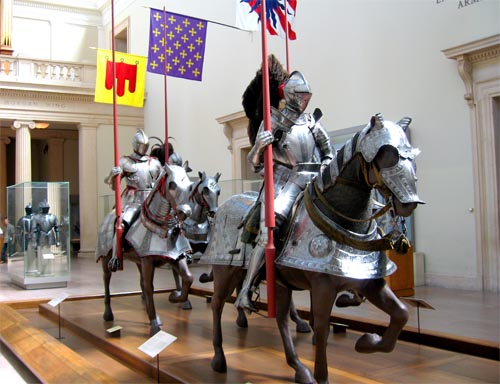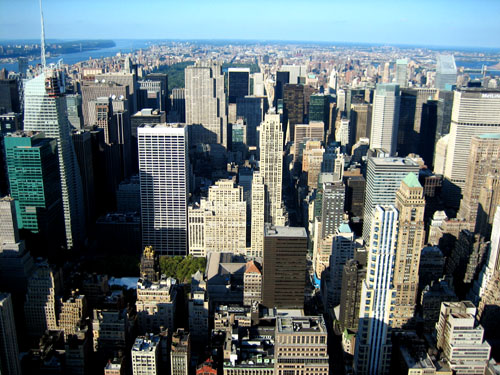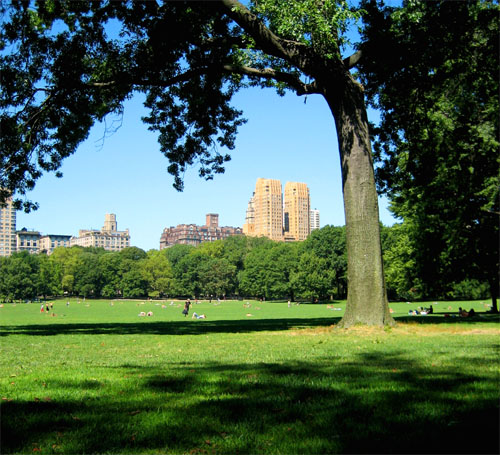Trip Report
I got back from my trip last Sunday night, but was too busy catching up on various things to write up a post about it until now.
Overall the trip was totally awesome! Except for a tropical storm at the beginning, the September weather was perfect for almost the entire time. I was able to see everything on my (long) list and even more. In fact, two weeks might even have been a bit too long: on the second-to-last day I realized that I had pretty much seen all the big-ticket sights, as all I had left to see that day were the semi-abandoned grounds of the 1964 World's Fair and under-demolition Shea Stadium (both somewhat underwhelming).
I had originally only planned to scope out a few of the top software companies, like Google and Fog Creek, but some unexpected turns of events left me with a lot of free time to explore others as well. I was somewhat surprised at the sheer number of cool software jobs and startup companies which were located in NYC. Google's offices in Chelsea were particularly awesome (er well, the building and location are awesome, but the 'offices' are actually more like cubicles and 'open workspaces' - I'm not sure what I think about those yet..). Of course, while I was there, the entire financial industry sort of imploded on itself, which will undoubtedly lead to a glut of thousands of out-of-work bank IT workers, pushing down programmer salaries there for some time. Million-dollar Wall Street bonuses probably won't be making appearances again for a while either..
I was able to get out of the city for a day and got a tour of Princeton, NJ from my friend Savraj who lives there working on his Y Combinator startup. The startup life sounded pretty cool. I was also considering going to Boston for a day (lots of interesting companies & opportunities there as well), but decided not to when I found out that it would have and cost 4 hours and $100 each way on Amtrak.
Due to the outrageous ticket prices, I only saw one Broadway show while I was there: The Lion King. I wasn't quite sure what to expect going in. Now that I've seen it, I suppose that if your goal was to make a Broadway musical out of that Disney movie, they did a good job. It was well staged, choreographed, and acted. But it also re-used most of the dialog from the movie, as well as the fart jokes (which, in the commentary, the directors of the movie admit were inserted in order to keep 6 year-olds from becoming bored), leading to many awkward, incongruous moments. It felt like nobody had ever stopped to ask "Wait, why are we making a musical out of this??" (In reality I'm sure that question was asked at some point, and the answer was "Because it will make millions of dollars!").
I'm sure that everybody has seen the internet-famous map of the distribution of single people in the US. It pointedly shows that the Seattle area has 40,000 more single men than women, but the NYC area has about 200,000 more single women than men. The dearth of attractive, single women in Seattle has certainly been stunning, so I was curious about whether the opposite effect would be noticeable in New York. It was quite noticeable - surprisingly so, even. There seemed to be beautiful women everywhere - on the street, in shops, on the subway, etc.. I'm trying to do the math to figure out whether this could have just been an anomaly (due to NY Fashion Week coinciding with my trip, or something like that). I'll run the numbers from the National Geographic article to calculate the "expected odds" and post the results up soon. Either way it was quite impressive.
Another particularly striking thing for me was the efficiency of the public transportation system. I had no car but didn't feel like I needed one at any point, since I could easily get to basically anywhere in the city using the subway. It really puts to shame the public transportation systems in cities like Denver or Seattle, which basically consist of "some buses". Building a real subway system in these sort of cities today would require absolutely astronomical amounts of money, so it's probably hopeless at this point.
During the second week I didn't bring my camera around as much unfortunately, but some of the pics I did take are below (the first week's pics are in the previous posts).
I took a whole lot of pictures from the top of the Empire State Building, figuring that I could find some software to stitch them all together into a panorama automatically. Interestingly enough, while I was there Microsoft Research released a free tool which does exactly that. It works pretty well, though it did screw up a few places like the Brooklyn Bridge. Here's a thumbnail of the panorama, linked to a larger version:
The larger version is still only 15% of the full-resolution image which is 16,000 pixels wide at 150 MB, way too big to upload here :).

I tried to attend a taping of the Daily Show, but I didn't realize that all the reserved tickets are gone months in advance, and the standby line was ridiculously long, even several hours before the taping (apparently the guest that night was some guy named Tony Blair). When I realized that I wasn't going to get in, I ran over to the Colbert Report studios, but by that time it was too late there as well.

Arms and Armor at the Metropolitan Museum of Art.

A cheese steak sandwich, which was quite good, but presumably also quite unhealthy.

Lions and gazelles at the Bronx Zoo.

The Unisphere from the 1964 New York World's Fair.

On the flight back all of the in-seat video consoles simultaneously crashed and rebooted during some turbulence (always a good sign..). I was only able to get a cameraphone pic of Tux before it was back up again.
Week 1 Update
No time for a full recap yet, so here are some pretty pictures to look at:
Rockefeller Center, NBC Studios
Vincent Van Gogh - Olive Tree
John Lennon memorial - Imagine
UN General Assembly hall
Apple 5th Avenue store (craziest Apple store ever)
WTC Ground Zero (on September 12th)
Statue of Liberty
Cars on the Brooklyn Bridge at night
Astroland amusement park at Coney Island (one week after it went bankrupt and closed, naturally)
NYSE on Wall Street (on Monday it was a total zoo due to the Lehman Bros/AIG/Merrill Lynch disaster)
New York City
So after thinking about it for a long time, I finally got around to going to New York City!
I got here on Saturday, and so far it's been awesome! (other than getting rained on by Tropical Storm Hanna)
I'm here for two weeks, which should be plenty of time to see all of the big-ticket attractions and some of the smaller ones too.
I'll write up a more detailed trip report when I get back, but for now here are some pretty pictures:

View from the Empire State Building, with Central Park visible in the background.

The view from Central Park.
Thoughts on (not) owning company stock
At work recently some discussion came up about owning stock in the company we work for. I briefly mentioned the fact that I do not own a single (vested) share of stock in the company and was treated with scorn and disbelief. Am I some sort of traitor? Do I not believe in the company? I tried to explain that no, it had nothing to do with any of that, but didn't get a chance to fully explain my reasoning. So here goes.
While the decision is certainly made easier by the fact that the stock in question has grossly underperformed the market for more than five years, I base my reasoning mainly on sound investment policy. Even if I worked at Google or Apple I would do the same (in theory, anyway).
It's all based on one basic principle: not being a sucker. There are three reasons why you risk being a sucker if you have large holdings in the company you work for, all related to diversification:
- If you are an employee of a company, your salary is tied to the fortunes of that company. If you have lots of stock in the company, then so is a large part of your savings. This is a very strong correlation, and correlation among financial assets is very bad. If anything bad happens to the company, you could lose not only your job, but also your savings. There are many examples of this happening - we've all heard the stories of the thousands of Enron employees who lost their jobs along with their entire 401(k)'s (100% Enron stock). A similar thing happened recently to all the United Airlines "employee-owners" who foolishly voted to convert their pension fund into United stock: the company went bankrupt, the stock became worthless, and many of them were laid off.
- It is a bad idea to own large amounts of any one individual stock, regardless. Each additional share has a 100% correlation with all the others and creates un-hedgable risk that the entire position might blow up. Examples of people losing large amounts of money on single stocks are so common that they're not even worth repeating here.
- Along the same lines, you don't want to have significant holdings in any one individual market sector either, because all of those stocks correlate fairly well with each other, and that correlation creates risk. There were many people who worked in the tech industry during the late 90's and "diversified" their portfolios by owning a variety of telecom and dot-com stocks (since those were the "hot" sectors). When the bubble popped, they had significant losses (and were probably laid off as well). So you don't want to own lots of stock in the sector you work in, which by definition includes your company.
At this point the common responses are along the lines of "Bah, I don't expect that our company (or market sector) is about to go bankrupt!". As Nassim Nicholas Taleb might point out: that's exactly the point. Nobody expected Enron to suddenly blow up: the sheer unexpectedness of it is precisely what made it such a spectacular disaster. If the market expects a company to go bankrupt, the stock will already be trading around $0, so it will be too late (see: Freddie Mac, GM, etc.). The unexpected events (so-called "black swans") can be the most risky and need to hedged against along with the run-of-the-mill risks.
With all that in mind, there are some questions which inevitably pop up:
- Don't you lose out big-time by immediately exercising stock options? Shouldn't you hold them for a while until the stock has gone up considerably? Sure, but those are stock options and are a different beast with their own set of incentives. But given the recent industry trend toward eliminating stock options and replacing them with stock "awards" and "grants", there are fewer and fewer incentives that favor the employee holding onto the stock. Companies started switching away from options after the Enron scandal in order to avoid large "surprise" expenses on their accounting books, which means that typical employees will no longer be "surprised" to strike it rich one day. With stock grants, there's basically no particular incentive for employees to hold onto the shares (and many disincentives, as discussed above).
- What about the tax implications? Won't there be unfavorable capital gains taxes if you sell immediately? At first I thought this would be a problem as well, but after looking into it, it turns out that it isn't. In fact, it can actually simplify your capital gains taxes if you sell all of your shares as soon as they vest. Stock grants are treated as ordinary income on vest, and some of the shares are withheld for taxes at that point. So the remaining shares have already been taxed, and if you sell at that point then there's neither a capital gain nor a capital loss, and thus no further tax implications. With no capital gain, there's also no particular incentive to hold the shares for at least a year in order to get the long-term capital gain tax rate.
- What about employee stock purchase plans? These work slightly differently, but end up being similar. Typical plans allow employees to purchase the company's stock at a given discount, like 10%. As long as the purchase date is the same as the vest date (with no backdating), then there's no capital gain (companies are also switching to this model in order to make their accounting simpler). The 10% discount is treated as ordinary income paid to the employee and is taxed at that rate. So again, with employee stock purchase plans, there's no particular incentive to hold onto the shares for any amount of time. If you sell them immediately after purchasing them, you can make an easy risk-free 7.5% return on your money (assuming a 10% discount and a 25% marginal tax rate).
So after all that, what should you invest all the remaining money in? That's a large topic which I will save for another post sometime in the future, but the answer is simple: just listen to Warren Buffet (the world's richest person) and buy an S&P 500 index fund. I deviate slightly from his advice since I feel that the S&P 500 weights your portfolio too heavily towards big U.S. multinationals and exposes you too much to downturns in the U.S. economy, so my investment strategy is basically to go with no-load S&P index funds plus some as-cheap-as-possible international index funds. I'll talk more about the reasoning and mathematics behind it in a future post.



